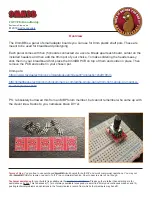
4
Screen display: dot matrix LCD is used, and the panel information is complete. Under
different panels, positive and negative flow, cold and heat, alarm information,
temperature sensor status and other contents can be displayed, and a variety of
parameter settings can be carried out. The screen supports 90
゜
, 180
゜
, 270
゜
.
Safety protection: the standard protection grades of sensors and calculators are IP65,
IP67 and IP68.
Applicable to a variety of fluids: different linings can be used to measure the flow and
temperature of a variety of fluids with different temperatures, physical and chemical
properties, such as central air-conditioning water, primary and secondary network hot
water in heat exchange stations, industrial refrigerant, etc.
Power off holding parameters: EEPROM is used to store configuration parameters
and cumulative data, which can be memorized in case of power failure.
Remote communication: support MODBUS or BACNET communication protocol
based on RS485 or MOSBUS communication protocol based on Bluetooth
communication.
Automatic switching of cold and heat: it has heat mode, cooling capacity mode and
automatic switching mode of cold and heat, and the display and accumulation of cooling
capacity and heat can be switched automatically.
Good lightning protection function and anti-static interference: the surge protection of
power line meets class A at 2KV; Electrostatic interference meets class a requirements
when contacting 6kV and gap 8Kv.
Complete reporting functions: support 1200 hours of time reports, 365 days of daily
reports, 36 months of monthly reports, 15 years of annual reports, 100 power on and
power off records and 100 error report records.
3.3 Working principle of heat metering
This heat meter includes the functions of temperature, temperature difference and
power measurement. Generally, the measuring medium is water. When the medium is
water, the pipe pressure needs to be set, and when using other media, the medium
density and enthalpy need to be set.
The setting parameter positions are as follows:
Media: detail - > power set - > medium
Pressure option: power->pressure opt
Media density: detail - > power set - > density (g/cm³)
Enthalpy: detail - > power set->heat C
The specific calculation method is as follows:
When the medium is water:
Power calculation p=q×ρTS×
(
HTs-HTr
)
Q is the measured flow;
ρTS is the medium density at the water supply end, which is obtained by looking
up the table according to the water supply temperature ts and pressure options;
HTS is the enthalpy value of the medium at the water supply end, which is
obtained by looking up the table according to the water supply temperature ts;
HTR is the enthalpy of the medium at the return water end, which is obtained by
looking up the table according to the return water temperature tr.








































